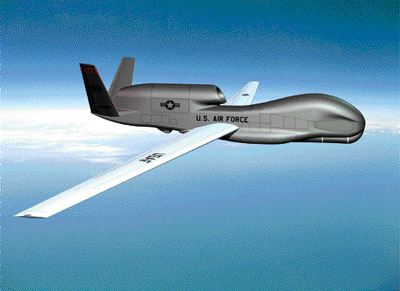Northrop Grumman's RQ-4B Global Hawk is expected to fly in the first quarter of 2006 and steps have been taken to curb spiraling programme costs, says Ed Walby, director, business development, HALE Systems, Northrop Grumman.
Speaking at the show Walby said production is under way on the RQ-4B, the second iteration of the company's high-altitude, long-endurance (HALE) unmanned air vehicle (UAV).
With the Global Hawk programme facing cost pressures, measures have been taken to bring more discipline.
"There are increasing requirements that have increased the cost of some of the components that we put on Global Hawk at the request of customers," Walby says.
"There were so many changes in the programme so rapidly, driving multiple changes to the programme.

Spiral
"The US Air Force recently decided that they would go ahead and stabilise the programme into blocks. Even though it's a spiral development programme, they're going to stabilise it into blocks and put some discipline into the rate in which we change the system."
RQ-4A Global Hawks are now considered Block 10, while Blocks 20, 30 and 40 are the phases dealing with converting the RQ-4A into the RQ-4B and refer to changes in payload and not necessarily changes in the aircraft itself, Walby said.
Walby also sought to deflect cost criticism of the programme. He stresses that "the cost growth is within the programme. The programme has no more dollars than it ever had."
This means that under the block system, if something in a particular block is changed, money is taken away from another part of the programme to pay for it.
The RQ-4B is being developed to enable the Global Hawk to carry multiple loads simultaneously, Walby says, adding that as there is a range of information customers want a combination of sensors.
The B model has an increased length of 14.5m (48ft) and an increased wingspan of 39.9m (130.9ft).
"The reason for this wing growth is to carry 3,000lb (1,360kg) of payload with the same engine and increase the generator size to produce enough electrical power to power sensors that you currently plan to carry and those sensors that haven't been invented yet," Walby says.
An illustration of the RQ-4B reveals that Northrop Grumman is planning to add under-wing pods. These pods have undergone preliminary testing.
Pods
Walby says the pods could be used for extra sensors. The US Air Force has no plans to weaponise its Global Hawks.
He also says NASA and the National Oceanic and Atmospheric Administration (NOAA) are interested in using Global Hawks to monitor earth warming by dropping temperature sensors from the pods at 60,000ft.
Source: Flight Daily News
















